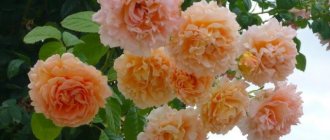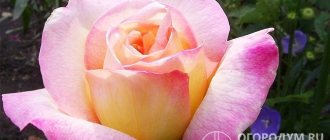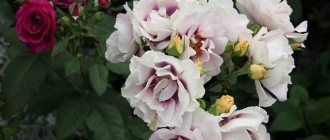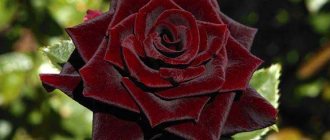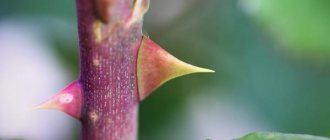general characteristics
Roses are an integral decoration of parks and gardens
These flowers belong to a large group of roses, including the following varieties:
- cultivated rose hips
- centifolia rose
- moss rose
This is a combination of the exquisite beauty of garden species and the unpretentious nature of plants growing in the wild.
all divided into the following subgroups:
- rose hip
- old garden varieties
- modern hybrids
In shape, the plant is a bush with strong shoots and reaching a height of 1-1.5 m, a diameter of 0.8-1.2 m. It is also erect, voluminous and with a dense leafy part. Some roses are related to climbing species.
Roses bloom profusely and for quite a long time (up to 2 months). Flowering can be one-time or repeated. The beginning falls at the end of May - beginning of June.
Inflorescence color: from white to dark purple, sometimes yellow or orange. The flowers come in varying degrees of terry and emit a strong, very pleasant aroma.
A combination of exquisite beauty and unpretentious character
The foliage of the plant is large, shiny, leathery, and disease resistant.
Roses have a very long root system (up to 2 m). This must be kept in mind when choosing a planting location. Also, this place should have a slight slope to drain excess water and be well lit in the morning and shaded in the afternoon and afternoon.
Roses belonging to park species are unpretentious, easy to plant and care for. But there are nuances. In the places where they grow, there should be no north and northeast winds and no high groundwater levels. Drafts and excess moisture adversely affect plant growth.
The soil should be loose and nutritious. A high humus content is desirable, PH 6-7. The best option would be loamy soil.
Varieties that bloom once are well resistant to cold weather. They do not require winterization.
Repeatedly flowering varieties are divided into types:
- very winter-hardy (scrubs)
- with medium durability
- frost-resistant with mandatory bending and shelter for the winter period
Advantages
Long duration and colorful flowering
The main advantages of park roses are:
- long duration and colorful flowering
- good endurance to the Russian climate
- wide range of species
- the ability to decorate and enliven the landscape in any design design
- good degree of resistance to diseases and pests
Flaws
Even with shortcomings, the love of flower growers does not decrease
The disadvantages include:
- poor tolerance of some varieties to winter without preparation
- demanding for proper watering and care
- the need to divide the bush after 4-5 years
English park rose
English park roses, as the name implies, were bred in the country of the same name at the end of the twentieth century as a result of complex crossing. They are also called “Austins” - named after the creator, breeder David Austin.
Most of them belong to the class of scrubs; they combine a beautiful bush and flower shape, bright intense aromas, and abundant continuous or repeated flowering. These are mainly spreading plants of medium height, densely covered with heavy flowers, although under different climatic conditions the same variety can exhibit different properties.
As a rule, all varieties of English park roses are undemanding in terms of care and soil, but do not tolerate prolonged wet weather well and can be affected by pests. Varieties with densely double and pompom flowers suffer especially from rains - due to the abundance of delicate petals, they simply do not have enough strength to bloom and they rot.
| Cardinal Richelieu | |
| One of the privileges of cardinals was the color of their robe. And this variety, which has won many world awards, will not go unnoticed in any garden thanks to the magnificent rich purple of its densely double bright flowers with a pale base. The flowers themselves are small, 5-6 cm in diameter, spherical, collected in clusters of 3-5 pieces, with a subtle but distinct aroma. Flowering occurs once (from early summer), but lasts for about two months. The variety forms neat, dense bushes up to 1.5 m in height, with thin drooping shoots almost without thorns and large dark green leaves. The plant is unpretentious, winter-hardy, moderately resistant to diseases, loves sunny areas and regular pruning. | |
| Golden Celebration | |
| This English rose not only has an incredible copper-sunny color and bright aroma, but also the huge size of the densely double flowers themselves, collected in small inflorescences - up to 16 cm! The variety forms a fast-growing, spreading, powerful, round-shaped bush up to 1.5 m high with arched, moderately prickly shoots and shiny bright green foliage. Heavy flowering begins in early summer and continues in rapidly repeating waves of reblooming into the fall. Golden Celebration is characterized by increased winter hardiness and high resistance to the most common diseases. Loves sunny areas and well-drained, sufficiently moist fertile loams. | |
| Winchester Cathedral | |
| This rose is a branched shrub up to 1.2 m high with dense matte dark green foliage. We love the variety for its abundant lush flowering in both summer and autumn. The flowers are densely double, about 9 cm in diameter, with a faint honey-almond aroma, collected in brushes of 3-5 pieces. They are cup-shaped, the outer petals bend back during flowering. Color – white or pale pale cream. Rose prefers sunny areas with slightly acidic, well-fertilized soil. The variety is cold-resistant and is little susceptible to fungal diseases. | |
| Remi Martin | |
| The variety forms dense, well-branched, erect bushes up to 1.5 m in height and up to 1.2 m in width. This is a repeat-blooming rose - the first wave of flowering occurs at the end of spring and lasts 3-4 weeks, the second begins after that almost immediately. The leaves are glossy, dark green. A distinctive feature of double flowers with a diameter of 6-8 cm, single or collected in small inflorescences, is a rich honey-apricot color and soft aroma. The variety develops best in a sunny, dry, cool climate, in areas with slightly acidic, well-drained and nutritious soil. Resistance to disease and rain is average. | |
| Scepter'd Isle | |
| This neat branched bush, low in our latitudes, is distinguished by almost continuous flowering throughout the warm period. In particularly favorable hot climates it can reach a height of 2 m. The flowers are about 10 cm in diameter, with a strong aroma. They are “deep”, cup-shaped, collected on long shoots with small foliage in clusters of 3-10 pieces. The color is a heterogeneous pink, more saturated in the center and pale on the outside of the flower. This rose is quite cold-resistant, but needs shelter for the winter. Prefers sunny or semi-shaded areas with neutral soil. | |
The best varieties
Park rose
The list of varieties below is the best for breeding them under the climate conditions of the Moscow region and the middle zone. They are not afraid of frost. Many of them do not require additional covering for cold seasons.
Martin Frobisher (Martin Frobisher)
Martin Frobisher
Martin Frobisher (Martin Frobisher) Canadian hybrid version of rugosa. Has excellent frost resistance. The bush is practically thornless. The inflorescences are large, consisting of 10-15 flowers. They are distinguished by their terry structure. Their color is milky pink. The shrub looks powerful, spreading and has many shoots.
Flowering is continuous (all warm season and until cold weather sets in). After the flowers fade, their petals fade and turn brown. They must be cut so as not to spoil the colorful appearance of the bush.
The peculiarity of the variety is resistance to many diseases, but suffers from black spot.
Ferdinand Pichard (Ferdinand Pichard)
Ferdinand Pichard
Ferdinand Pichard (Ferdinand Pichard) A remontant (blooms 2 times in the summer) hybrid, belonging to the varieties of old garden roses. Large bush:
- height – 1.2-2.4 m
- width – 0.9-1.2 m
The flowers are not monochromatic (with stripes), with a large number of petals, with a soft pink color. Their structure is terry and loose. The flowering is fragrant, bright, fragrant.
The variety has the ability to withstand low temperatures down to -310C without shelter, and is resistant to diseases. Old branches need to be pruned every year, and young ones need to be bent.
Piano
Piano
Piano (Piano) Remontant species with abundant flowering. Has high resistance to cold. Shrub dimensions:
- height – 0.6-0.8 m
- width – about 0.6 m
The inflorescences are collected from 5 rather large (up to 11 cm), double, scarlet flowers. When they bloom, they undergo a transformation process: from a colorful spherical shape they turn into a cup-shaped shape with compacted petals.
This representative is not sensitive to diseases.
Louise Bugnet (Louise Bagnet)
Louise Bugnet
Louise Bugnet Canadian hybrid rugosa with resistance to cold (up to -340C) and disease. No additional wrapping is required. Blooms in waves, fragrantly, all summer. Various colors: pearl pink, white, pastel pink.
There are varieties with changing colors during the blooming period. The inflorescence is collected from 5 flowers. They are large and terry.
Cuthbert Grant
Cuthbert Grant
Cuthbert Grant (Cuthbert Grant) A variety of Explorer rose. A colorful Canadian species with a high degree of winter hardiness (up to -370C) and disease resistance. The shrub is erect and large. Its branches droop gracefully. The inflorescence is collected from 5-9 flowers. They are large, cup-shaped, dense, velvety. They are crimson-red in color with a burgundy tint. It blooms a second time: in the first half of spring and at the end of summer.
There is no need for special protection for cold seasons.
JP Connell (JP Connell)
JP Connell
JP Connell (JP Connell) The variety has high disease tolerance, but does not cope with black spot. Withstands frosts down to -370C without insulation. It is a variant of the Explorer series. The upright bush is large in size. The flowers are rather large, cup-shaped, and double. They are collected in brushes (up to 7 pieces). The color of the flowers is bright yellow, and after they bloom - cream.
Slow growing variety. It cannot be cut. It blooms twice: at the end of spring - at the beginning of summer, at the end of summer.
Marchenland
Marchenland
Marchenland (Marchenland) Captivates with a gentle, classic look. It has a peculiar color: pastel apricot color mixed with salmon tones. The flowers are large (up to 8 cm). They have a light aroma. There are up to 40 of them in an inflorescence. the foliage is also large, numerous, with a shiny surface and dark green color. Flowering is abundant, continuous throughout the summer and until the onset of cold weather.
It has a powerful, tall (0.8-1.5 m) bush that does not require pruning. The variety is resistant to diseases and has high winter hardiness. Prefers sunny areas. The soil must be fertile and well drained.
Prairie Joy
Prairie Joy
Prairie Joy The height of a bush of this variety can reach 1.5 m, width - 1.25 m. This is possible if favorable conditions have been created for the full development of this rose. It is distinguished by large bright pink flowers. They have a pleasant, faint aroma. Densely double and semi-double inflorescences are formed on one bush.
It blooms luxuriantly throughout the summer, with short breaks. Flowering begins at the end of June. The bush is strong, branched, slightly thorny.
Has great demands on soil. It should be moisture-absorbing and rich in humus. The variety is resistant to winter. No additional cover is required. Light pruning is needed.
Morden Fireglow
Morden Fireglow
Morden Fireglow A repairable species with good winter resistance. He is not afraid of frost down to -370C without protective shelter. It is advisable to simply hill up the soil.
The crown is large (0.8-1 m), erect. It blooms for the first time in early spring, and again at the end of the summer season. It is better to prune the bush in early spring.
The buds are large, goblet-shaped. They are collected in inflorescences of 5 pieces. Their color is orange-red. Flowering is fragrant.
This rose is grateful for regular fertilization. Prefers rich soil with a sufficient amount of humus.
Chinatown
Chinatown
Chinatown (Chinatown) The variety can withstand the frosty weather of a harsh climate if it is planted in an area that is protected from cold winds, and the branches are bent and well sprinkled.
It develops fully and blooms well in fertile, fresh soil, in which excess moisture does not stagnate. The rose needs regular fertilization.
Loves places that are well lit, but direct sunlight can cause the flowers to fade. Therefore, it is better to grow in partial shade.
The beautiful appearance of the bush with dense foliage looks impressive. It reaches a height of 0.9-1.1 m. The shape of the buds is goblet-shaped, pointed. Color – creamy yellow with dark pink specks. The flowers are gorgeous, cup-shaped and full. Diameter – up to 10 cm. Color – yellow, sometimes with a pink tint. Scrubs bloom profusely, continuously, with a persistent pleasant aroma. The leaves have a dense structure, dark green, glossy.
The re-blooming variety is able to decorate landscape design, both in single plantings and in a group with other plantings.
John Franklin (John Franklin)
John Franklin
John Franklin The English park rose, which is weakly resistant to frost, is a beautiful result of breeders. Belongs to the Explorer series. It successfully endures winter only if the shoots are insulated.
The crown is erect. The many branches are covered with dense, dark green, glossy foliage. The leaf shape is round.
The flowers are semi-double, large in size (up to 6 cm), with a deep red color. Collected in brushes of 3-5 pieces. (if the rules of planting and care are followed, their number can reach up to 30 pieces).
It does not suffer from powdery mildew, but is affected by black spot when there is persistent dampness in rainy weather.
Floribunda Remy Martin (Remy Martin)
Remy Martin
Floribunda Remy Martin (Remy Martin) A variety of English rose that can bloom several times per season. Differs in frost resistance.
Bush dimensions:
- height – 1-1.5 m
- width – up to 1 m
Flowering is delicate, apricot color. The flowers have a large, classic shape. The number of petals reaches 25 pcs.
The variety is resistant to powdery mildew.
Louise Odier (Louis Odier)
Louise Odier
Louise Odier (Louis Odier) Belongs to the classification of park bush roses. Tall (up to 1.5 m). remontant variety. The foliage is dense, large in size, and pale green in color. The flowers are large (up to 8 cm), double, cup-shaped, with a strong, persistent scent. Their color is bright pink.
It has low susceptibility to diseases and requires additional protection during the cold season. Also, this representative is particularly picky about the choice of planting site and care. It prefers distance from other brethren, but feels great in the vicinity of coniferous bush species.
Fluorescent
Fluorescent
Fluorescent This specimen is not particularly resistant to harsh winters and various diseases. Temperatures below -200C without additional shelter are detrimental to the plant.
Blooms bright red, continuous. Ends in autumn before frost. Flowers are not subject to shedding or fading.
In cases where the bush freezes a little, it has the ability to quickly recover. The cuttings take root well.
Westerland
Westerland
Westerland Tall (2.4 m), fragrant, repeat blooming, bright orange rose. On a clear sunny day it can change color to pink with yellow in the middle.
The variety is quite resistant to diseases, low temperatures, and rain (the flowers do not fall off). During the winter season, insulation is required.
The flowering is beautiful, semi-double, throughout almost the entire summer. Leaf color is olive green.
The shoots are fragile, so they need support. A suitable option would be to plant a rose against a wall.
Pink Grotendorst
Pink Grotendorst
Pink Grotendorst Roses are bred by crossing Rubra rugosa and a polyanthus species that is little known.
It is distinguished by an unusual shape of inflorescences (similar to carnation crops), abundant, continuous flowering, and resistance to diseases. The flowers are miniature (3-4 cm), fragrant. Their color is crimson red or pink. They are grouped into inflorescences (5-20 pieces) and do not fall off from rain. The bush is erect, not exceeding 1.5 m in height and width, with a large number of thorns. The foliage is dark green with a glossy surface.
Lady of Shalott
Lady of Shalott
Lady of Shalott One of David Austin's rose varieties. Flowering is repeated, continuous, double, fragrant, peach-orange in color. The edges of the petals are colored with a pinkish tint.
The shrub is tall (up to 2 m), with a large number of branches and the ability to grow quickly. Does not survive winter without shelter. Drops flowers during long hot weather.
History of creation and description of the variety
The Remy Martin variety appeared thanks to the fruitful work carried out by breeder Rene Royon. It was developed in France in the last century, namely in 1995. Other names of the culture: STARqueli, Magic Lantern.
The noble plant belongs to the floribunda group. This perennial looks very elegant: just imagine a stately shrub from 1.5 to 1.8 meters in height, with branched, thornless shoots and dense, dark green foliage with a semi-glossy sheen. The crown of the rose in girth is no more than a meter. In spring, the crop acquires pointed, elongated buds consisting of 25-35 petals. When they bloom, they turn into double, cup-shaped flowers with a diameter of 6 to 8 cm, copper-golden in color with apricot notes. During the flowering period, the outer flower petals acquire a pinkish color. The flowers of this plant can be either single or formed in inflorescences of 2–5 pieces. They emit a fairly intense, but at the same time pleasant, soft and unobtrusive aroma. The flowering of the crop is long, abundant, and repeated. It begins in May and lasts about three weeks.
The beautiful floribunda is practically not susceptible to fungal and bacterial diseases. True, its resistance to powdery mildew is somewhat higher than to black spot. The lush flowers of the graceful Remy Martin do not lose their impeccable appearance under the influence of rain. In the sun, the petals of a cheerful rose do not fade or bake. The variety has average winter hardiness: it can withstand frosts down to -23ºС. For this reason, the rose needs shelter with the onset of cold weather.
Features when planting
Gorgeous flowering in comfortable conditions
For comfortable growth, full development, and abundant flowering, the rose must be planted in an area with good ventilation and without drafts. In addition, this flower loves the sun very much.
It, of course, can grow in a dark place, but with poor flowering. For this reason, it is not recommended to plant the plant near large trees or tall buildings that will shade it.
As for the soil, the rose is not particularly capricious in this regard.
Any composition is suitable for it. But the best option would be to use clay soil with a high humus content.
Also important is good oxygen saturation of the soil. For heavy soil, peat or compost is added to improve it. But everything is good in moderation. Too light soil is not suitable. Then it is fertilized with manure or turf soil.
Transplanting a rose with installing a trellis
Direct disembarkation process:
- A hole is dug. Its depth should be such that the root system of the rose is freely located in it
- Compost soil is poured at the bottom. Bone meal is added to it. You will need to feed the plant only after a year.
- Next is the seedling. Its roots should not bend upward. You also need to monitor the location of the root collar. It should be a few centimeters deep
- The hole is filled in and compacted
- The seedling needs to be watered
When planted in autumn, the rose is prepared for the upcoming cold snap. For this purpose, high mounds are made. The opening of the seedling takes place in early April.
Features of agricultural technology
Remy Martin prefers sunny places, but also grows well in partial shade. It is advisable to place it in an open space where there is good air circulation. This will help avoid the occurrence of diseases on the plant and reduce the risk of attack by insect pests.
The decorative perennial is demanding on soil quality. It should be planted in loose, moderately moist, fertile soil with a slightly acidic reaction and good drainage. It is in such a substrate that the crop will grow well and bloom luxuriantly. The pit for planting the plant is prepared in advance. It should be deep enough so that the roots of the seedling can be freely located in the hole. It is advisable to add organic fertilizer to the planting hole: compost or rotted manure. Floribunda is planted in the spring, and the root collar should be 4-5 cm below the soil level.
You definitely need to take care of your rose. For Remy Martin, regular watering, fertilizing, pruning, preventive spraying with a solution of insecticide and fungicide, loosening the soil under the bush and mulching are important. Water the plant 1-2 times a week. Consumption of soft, warm water for an adult crop: 1.5-2 buckets. Fertilizers are applied to the flower up to 4 times a year. With the arrival of spring, when the buds on the plant begin to swell, it is fed with saltpeter. During the budding phase, preference is given to fertilizer with a large amount of phosphorus in the composition. After the first flowering, phosphorus-potassium concentrate is added. Finally, in late autumn the plant is fed with potassium fertilizer.
It is necessary to loosen the soil under the bush only after watering, but not immediately, but at least after a day. Then it is mulched with sawdust, humus or peat. Do not neglect timely pruning of Remy Martin. This procedure is indicated for decorative perennials from the third year of life. In the spring, weak and dead shoots are removed, and up to 9 stems are left from the strong ones. In the fall, all the branches of the plant are cut off somewhat, then the rose is covered with dry soil and covered for the winter. Treatment with special preparations in order to prevent the appearance of harmful insects and diseases is required for the plant three times during the growing season.
All the nuances of proper care
When working, protective equipment is required to avoid injury.
The autumn period, namely the first half of autumn, is the best time to plant park-type roses. The plant will have time to create new roots before the onset of cold weather. This will greatly help him to develop well with the onset of spring. It is advisable that the soil be prepared in advance, half a month before planting.
During the first 3 years, the rose is provided with the following care:
- the soil around the bush is often loosened
- fertilizing is applied using special fertilizers (3-4 times during the summer season)
- In autumn, manure is applied as fertilizer
- in spring (from May to June), to stimulate the growth of new side shoots, the stems are sprayed (2-3 times)
It is at this time that the main stems of the plant are formed and a strong root system is formed. Therefore, careful care is required.
Correctly made cut
The best time to trim shoots is spring. This is an extremely necessary procedure. But for the first 2 years it is not carried out. Next, the rose is given the shape of a bowl. To do this, only weak and sluggish shoots are removed.
Over time, the bush grows greatly and loses its grooming, which complicates its care. This problem is solved by pruning. This allows you to rejuvenate the plant. In autumn, all the oldest and non-flowering branches, as well as most of the small growth, are cut off.
When working with roses, protective equipment is required, because... they are prickly. Gardening gloves and a canvas apron will prevent possible skin damage.
Varieties of English park rose
| general characteristics | upright bush |
| Plant height | 100-150cm |
| Flower size | 80-120 cm |
| Color | White to dark purple |
| Bloom | From late May to mid October |
| Winter hardiness | Frost-resistant variety (up to -25ºС) |
| 1. Rose shrub belvedere (lat. B elvedere ) |
Description:
- shape - powerful bush;
- bush height - 120 - 15 cm;
- width - 90 - 120 cm;
- very large flowers, 10 - 12 cm, densely double, orange-peach, do not bloom for a long time, do not fade in the sun, collected 2 - 3 flowers in an inflorescence or single, have a pleasant tart aroma;
- flowering - abundant, triple;
- leaves - dense, dark green, shiny;
- the variety is resistant to powdery mildew and black spot and is moderately resistant to rain;
- winter hardiness - zone 5
Preparing for winter
Additional shelter can protect against serious temperature changes
The thoroughness of preparation for the winter period depends on the climate and the selected variety. A mature bush is quite resistant to low temperatures and therefore does not particularly require additional shelter. The situation is different with young plants.
They are covered for the winter by performing the following steps:
- earth is piled up at the base of the bush
- branches are wrapped in craft paper (preferably there are several layers)
This work will protect the young plant from serious temperature changes, which will enable it to overwinter safely.
Diseases and pests
Black spot
The most common diseases and pests of roses include:
- Black spot
A common problem that gardeners face when growing roses. This disease is caused by the fungus Diplocarpon rosae. It develops in warm and humid conditions. At first, the manifestations are invisible. But when the first spots appear, it is necessary to take immediate action, because the fungus spreads very quickly (spores are produced every 3 weeks).
Indicators of damage are small black spots on the foliage. They are gradually growing. The foliage first acquires a yellow tint along the edges, and then completely turns yellow and flies off. Rose is dying.
To cure this disease, it is necessary to treat the bush 3 times per season. For this purpose, drugs based on the fungicide mancozeb or triazole are used. For the winter, all foliage is removed and burned. The soil is treated with a product containing copper. This will help kill the fungus, which can survive the winter and come back to life as the weather warms up.
- Cercospora (grayish spotting)
Cercospora
The cause of the disease is the fungus Cercospora rosicola. It also appears on the foliage in a large number of dark spots. Later they acquire a purple halo, and in the middle they become grayish. Then the leaves die.
For treatment, the bush is treated with a systemic fungicide, and diseased leaves are removed. In preparation for winter, the green mass is destroyed and the soil is treated with a copper-containing preparation.
After cutting, diseased parts are not suitable for composting. This is a big risk for other plants.
- Rust
Rust
The cause is the fungus Phragmidium, which is favored by warm and humid weather conditions.
The manifestation of the disease varies. It depends on the stage of development of the fungus:
- April - May - the deciduous part and shoots are affected by yellow-orange growths (tubercles), the branches become twisted and dry out
- July - the reverse side of the leaves becomes covered with small rusty-brown blisters (pustules), then the foliage acquires a yellow-red hue, the branches become thick, cracked and dusty with spores
- August - September - winter spores begin to form in the bubbles, and black spots appear on the foliage. Later she crumbles all over
For medicinal purposes, damaged parts are cut off and destroyed in fire. The shrub is treated with a fungicide, and to prevent the onset of heat, foliar feeding and spraying of the crown are carried out. For this, 0.3% solutions of potassium nitrate or superphosphate extract are used.
To prepare the hood you will need:
- double superphosphate – 100 g
- water – 1 l
Superphosphate is poured with hot water, mixed and boiled for 30 minutes with constant stirring. Next, the mixture is cooled and filtered using thick gauze.
- Powdery mildew
Powdery mildew
The source is the fungus Sphaerotheca pannosa. It grows well under hot, dry daytime and cool, humid nighttime conditions.
The disease manifests itself in the form of wrinkling and curling of leaf blades and a white coating of mold on the stems.
The scourge will not develop if the seedling is planted in an area with good ventilation. During the treatment period, the plant is not fed and is pollinated 2-3 times with ash. Also used for processing are 1% Bordeaux mixture and 0.4% oxychloride solution. There may be other fungicides with similar effects.
- Bacterial cancer
Bacterial cancer
A dangerous disease caused by the bacterium Agrobacterium tumefaciens. Because of it, the rose cannot absorb moisture and nutrients. This impairs development. Leads to death.
The pathogen enters through wounds formed after cutting, breaking branches, and also from carelessness during replanting. This manifests itself in the form of pale growths. They have a round shape. Appear in the area of the root collar. During development, the growths become larger in size, tougher and spread to the trunks and roots.
An infected plant cannot be treated. It is dug up and burned. The soil also becomes contaminated and cannot be used to grow other vegetation for 5 years.
To avoid problems, pruners and knives are treated with a 1% solution of potassium permanganate before the cutting procedure. Also, purchased seedlings are carefully inspected.
- Rezucha mosaic virus
Rezucha mosaic virus
Cannot be transmitted between plants. The method of propagation is vegetative propagation. The Arabis mosaic virus (ArMV) virus appears in the form of small yellow spots on the leaves, which subsequently expand and form into a mosaic image.
The disease has no cure. Affected areas are cut off and burned. For precautionary purposes, garden tools used for pruning and other work are disinfected.
- Garden beetle (Phyllopertha horticola)
Garden beetle
This scourge is dangerous for roses, many fruit and berry crops, and the lawn. This is a large beetle with a shiny back. The buds and foliage of plants are eaten.
If there is a small amount of the pest, it is collected by hand and destroyed. Everything is carefully inspected for the presence of larvae. In case of severe reproduction, contact insecticidal preparations are used.
- Green rose aphid (Macrosiphum rosae)
Green rose aphid
It is also a pest of the entire garden. Represents an insect. It looks fragile. It has a soft green, brown or black color. Can suck all the juice out of a rose. It is also a carrier of infections.
Affected plants are immediately visible. Aphids cling to the reverse side of foliage, crowns, and unopened inflorescences, leading to their deformation.
To combat the parasite, it is collected manually and destroyed. When widespread, the plant is treated with insecticides.
Attracting ladybugs to your garden plot will help in preventive measures. They are the enemies of this insect.
- Weevil (Curculionidae)
Weevil
Another name for an elephant. It damages leaves on which gnawed arched holes form, as well as buds on the petals of which torn holes remain. Damage is also caused to the root system. The insect uses plant buds to lay eggs.
As measures against the pest, its larvae and adults are collected and destroyed, and the crown is treated with insecticides with a wide spectrum of effects.
- Rose sawfly (Arge ochropus)
rose sawfly
To lay eggs, the caterpillar cuts the foliage of the plant. The pulp of young branches is used as food. Later they acquire a dark shade and dry out. The foliage of the plant is also eaten. This affects how it grows, leading to its deformation and weakening.
The insect is a small pale green caterpillar.
As a treatment, the damaged areas are cut off. The plant is treated with contact insecticides. Digging up the soil under the bush in the autumn will help destroy insects that have settled there for the winter.
To summarize
Undoubtedly, park roses will become a particularly colorful decoration of any territory. They have a wide variety of varieties. There is an ideal option for all flower growers. In addition, the flower does not require much time to care for itself.
The main thing is to properly care for it and carry out preventive procedures in a timely manner to prevent problems with pests and diseases. Following the instructions will allow you to grow a real highlight of any area in the form of a strong, beautiful rose bush.
